Denim clothing company Levi's (NYSE:LEVI) reported results in line with analysts' expectations in Q1 CY2024, with revenue down 7.8% year on year to $1.56 billion. It made a non-GAAP profit of $0.26 per share, down from its profit of $0.34 per share in the same quarter last year.
Levi's (LEVI) Q1 CY2024 Highlights:
- Revenue: $1.56 billion vs analyst estimates of $1.55 billion (small beat)
- EPS (non-GAAP): $0.26 vs analyst estimates of $0.21 (24.8% beat)
- Gross Margin (GAAP): 58.2%, up from 55.8% in the same quarter last year
- Free Cash Flow of $214.4 million, similar to the previous quarter
- Market Capitalization: $7.46 billion
Credited for inventing the first pair of blue jeans in 1873, Levi's (NYSE:LEVI) is an apparel company renowned for its iconic denim products and classic American style.
Levi's is headquartered in San Francisco and was originally founded to capitalize on the California Gold Rush. Since then, the company has expanded its reach to more than 110 countries, offering a range of clothing and accessories.
Levi's primarily operates under three major brands: flagship Levi's, Signature, and Denizen. It also owns the Dockers and Beyond Yoga brands, though they make up a smaller percentage of sales. Each brand caters to different consumer needs and market segments, yet all retain the core values of quality and durability that the company is known for.
The company’s marketing and retail strategy is key to maintaining its relevance. Levi's employs a mix of traditional and digital marketing, tapping into nostalgia while engaging with younger audiences through social media. The company’s retail presence spans flagship stores, department stores, online platforms, and a global network of franchisees, ensuring widespread accessibility to its products.
Apparel, Accessories and Luxury Goods
Within apparel and accessories, not only do styles change more frequently today than decades past as fads travel through social media and the internet but consumers are also shifting the way they buy their goods, favoring omnichannel and e-commerce experiences. Some apparel, accessories, and luxury goods companies have made concerted efforts to adapt while those who are slower to move may fall behind.
Levi's primary competitors include Wrangler and Lee (owned by Kontoor Brands, NYSE:KTB), Gap (NYSE:GPS), American Eagle Outfitters (NYSE:AEO), and Calvin Klein and Tommy Hilfiger (owned by PVH Corp, NYSE:PVH).Sales Growth
Examining a company's long-term performance can provide clues about its business quality. Any business can put up a good quarter or two, but the best consistently grow over the long haul. Levi's annualized revenue growth rate of 1.3% over the last five years was weak for a consumer discretionary business. 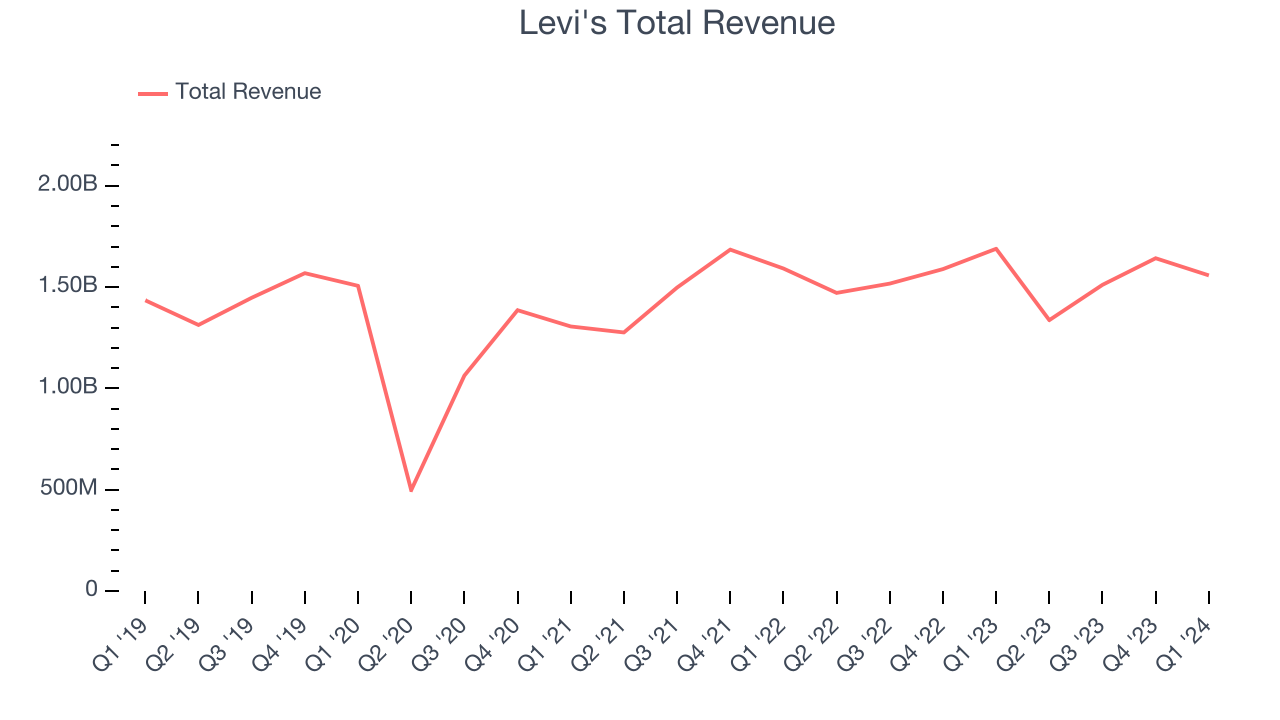 Within consumer discretionary, product cycles are short and revenue can be hit-driven due to rapidly changing trends. That's why we also follow short-term performance. Levi's recent history shines a dimmer light on the company as its revenue was flat over the last two years.
Within consumer discretionary, product cycles are short and revenue can be hit-driven due to rapidly changing trends. That's why we also follow short-term performance. Levi's recent history shines a dimmer light on the company as its revenue was flat over the last two years.
Levi's also reports sales performance excluding currency movements, which are outside the company’s control and not indicative of demand. Over the last two years, its constant currency sales averaged 2.3% year-on-year growth. Because this number is higher than its revenue growth during the same period, we can see that foreign exchange rates have been a headwind for Levi's. 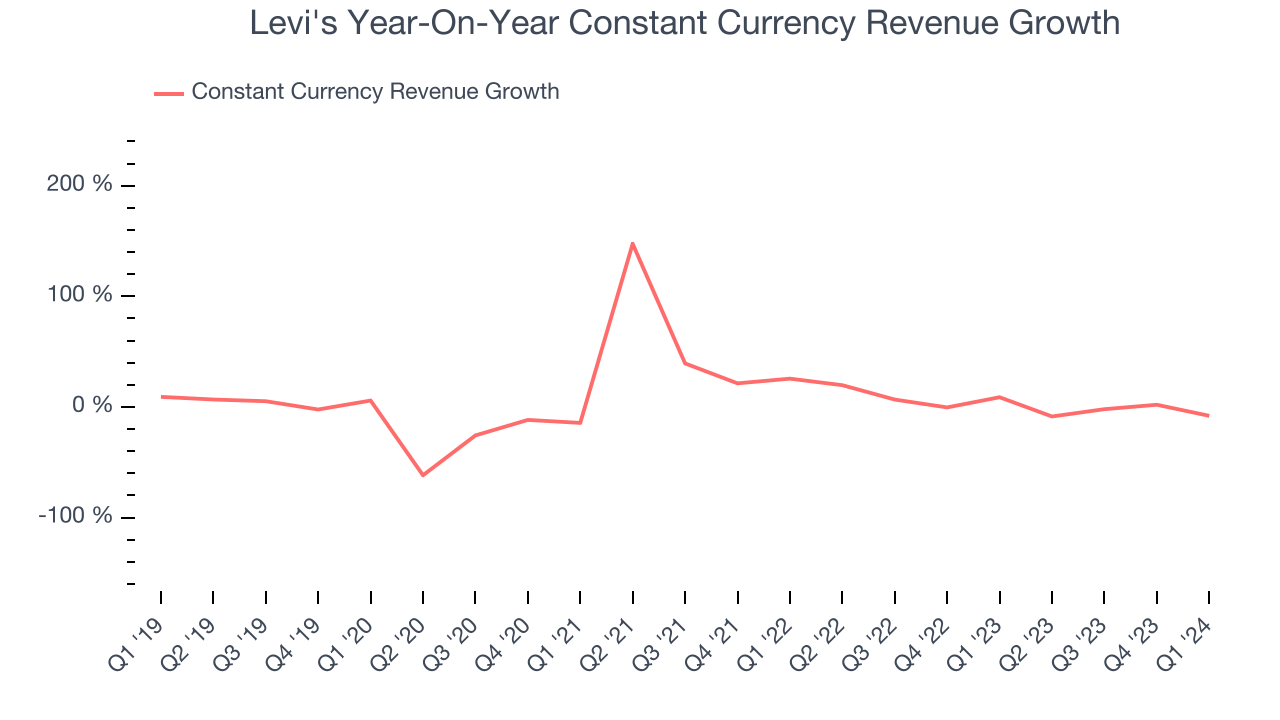
This quarter, Levi's reported a rather uninspiring 7.8% year-on-year revenue decline to $1.56 billion of revenue, in line with Wall Street's estimates. Looking ahead, Wall Street expects sales to grow 6.3% over the next 12 months, an acceleration from this quarter.
Operating Margin
Operating margin is an important measure of profitability. It’s the portion of revenue left after accounting for all core expenses–everything from the cost of goods sold to advertising and wages. Operating margin is also useful for comparing profitability across companies with different levels of debt and tax rates because it excludes interest and taxes.
Levi's was profitable over the last eight quarters but held back by its large expense base. It's demonstrated subpar profitability for a consumer discretionary business, producing an average operating margin of 6.2%.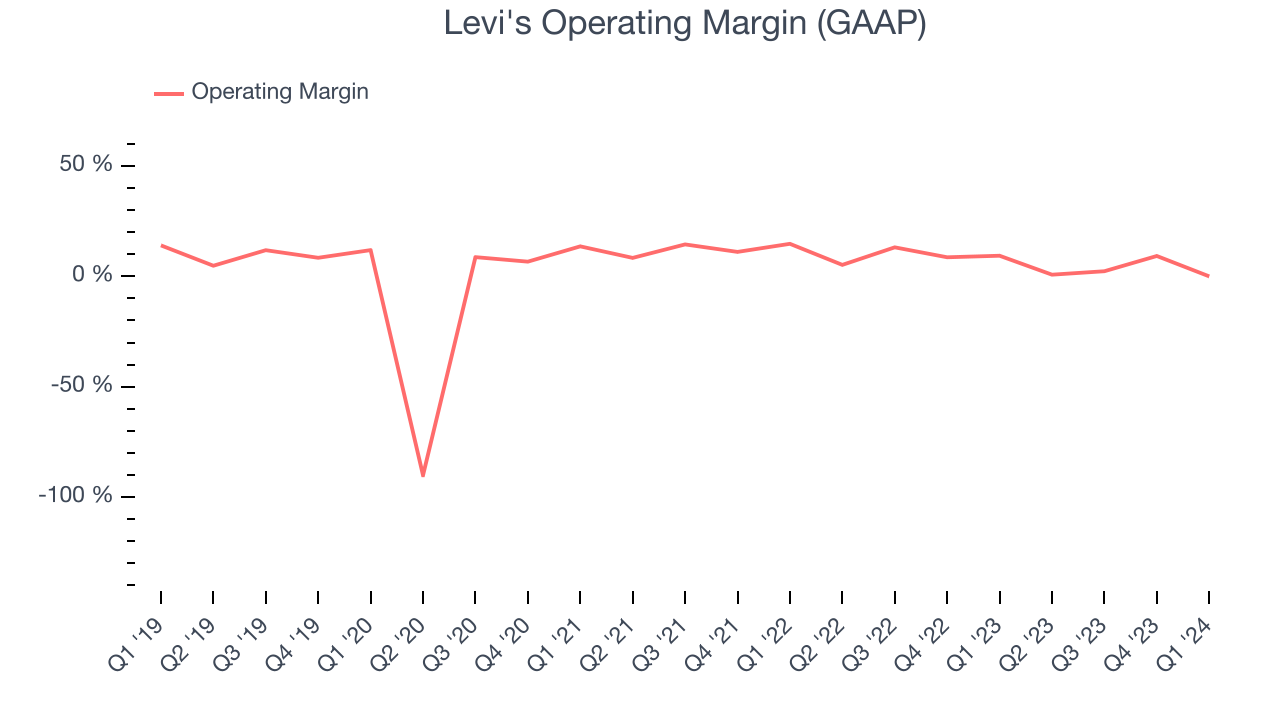
In Q1, Levi's generated an operating profit margin of negative 0%, down 9.3 percentage points year on year.
Over the next 12 months, Wall Street expects Levi's to become more profitable. Analysts are expecting the company’s LTM operating margin of 3.2% to rise to 10.7%.EPS
Analyzing long-term revenue trends tells us about a company's historical growth, but the long-term change in its earnings per share (EPS) points to the profitability and efficiency of that growth–for example, a company could inflate its sales through excessive spending on advertising and promotions. 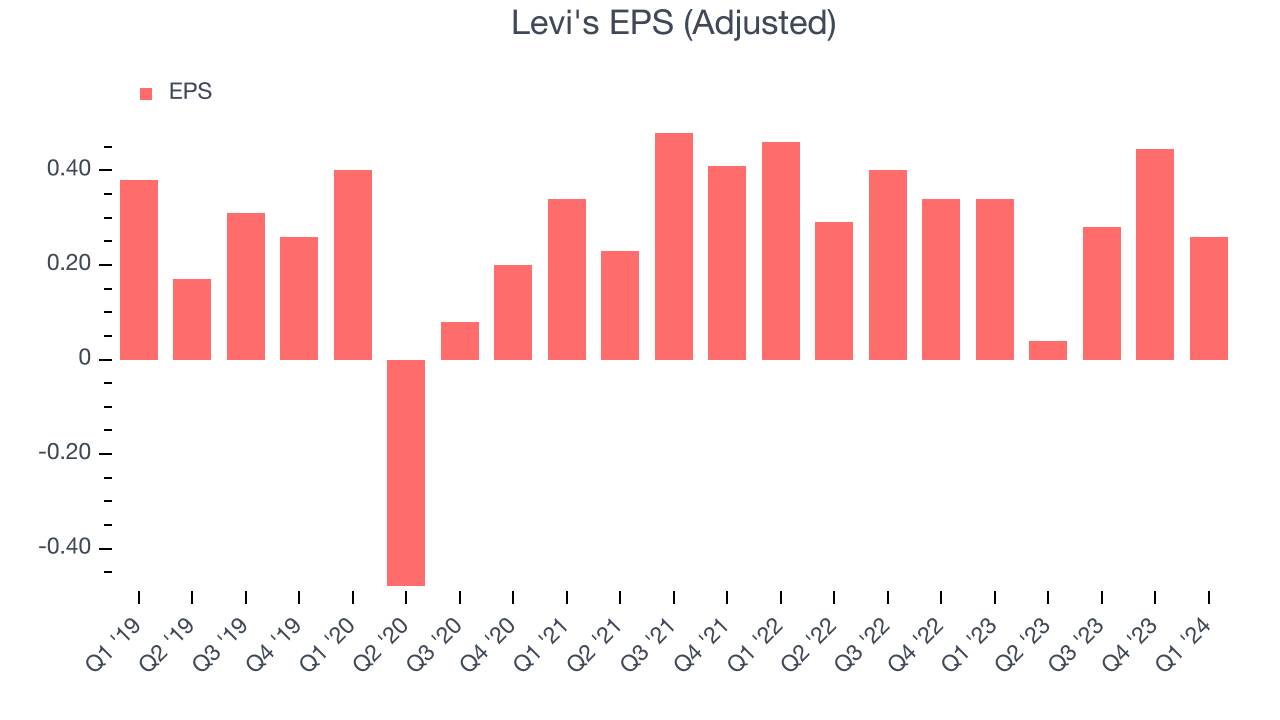
Over the last five years, Levi's EPS dropped 19.3%, translating into 3.6% annualized declines. Thankfully, Levi's has bucked its trend as of late, growing its EPS over the last three years. We'll see if the company's growth is sustainable.
In Q1, Levi's reported EPS at $0.26, down from $0.34 in the same quarter a year ago. This print beat analysts' estimates by 24.8%. Over the next 12 months, Wall Street expects Levi's to grow its earnings. Analysts are projecting its LTM EPS of $1.02 to climb by 28.2% to $1.31.
Cash Is King
If you've followed StockStory for a while, you know we emphasize free cash flow. Why, you ask? We believe that in the end, cash is king, and you can't use accounting profits to pay the bills.
Over the last two years, Levi's has shown mediocre cash profitability, putting it in a pinch as it gives the company limited opportunities to reinvest, pay down debt, or return capital to shareholders. Its free cash flow margin has averaged 2.3%, subpar for a consumer discretionary business.
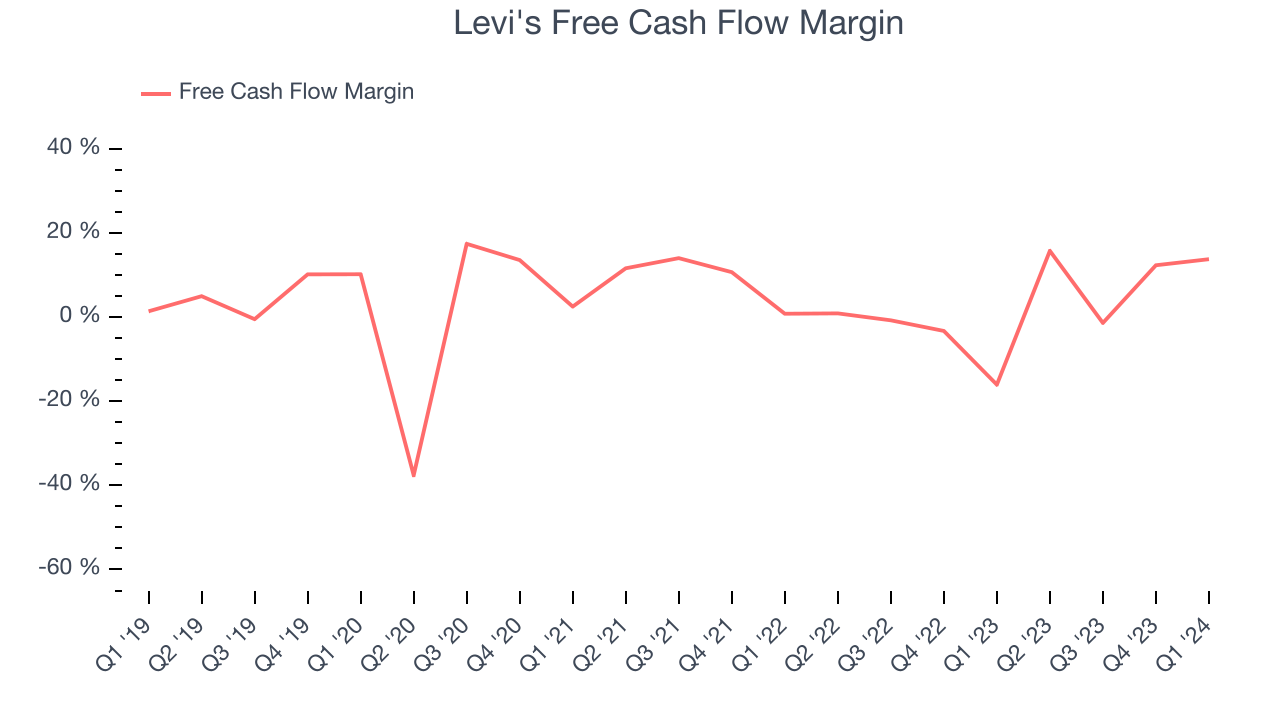
Levi's free cash flow came in at $214.4 million in Q1, equivalent to a 13.8% margin. This result was great for the business as it flipped from cash flow negative in the same quarter last year to cash flow positive this quarter.
Return on Invested Capital (ROIC)
EPS and free cash flow tell us whether a company was profitable while growing revenue. But was it capital-efficient? A company’s ROIC explains this by showing how much operating profit a company makes compared to how much money the business raised (debt and equity).
Levi's five-year average return on invested capital was 14.7%, somewhat low compared to the best consumer discretionary companies that pump out 25%+. Its returns suggest it historically did a subpar job investing in profitable business initiatives.
The trend in its ROIC, however, is often what surprises the market and drives the stock price. Unfortunately, Levi's ROIC over the last two years averaged 4.3 percentage point decreases each year. In conjunction with its already low returns, these declines suggest the company's profitable business opportunities are few and far between.
Key Takeaways from Levi's Q1 Results
We were impressed by how significantly Levi's blew past analysts' EPS expectations this quarter, driven by growth in its Direct-to-Consumer (DTC) sales in all business segments. As a reminder, DTC revenue has higher margins than wholesale revenue because the company can charge higher prices. Furthermore, the company stated its revenue would have been flat year on year excluding its Russia business and divestiture of Denizen.
Levi's also declared a dividend of $0.12 per share ($48 million total). The dividend is payable on May 23, 2024, to shareholders of record on May 9, 2024. The company's full-year revenue and EPS guidance were in line with Wall Street's projections.
Overall, this was a mediocre quarter for Levi's. The stock is up 6.4% after reporting and currently trades at $19.86 per share.
Is Now The Time?
When considering an investment in Levi's, investors should take into account its valuation and business qualities as well as what's happened in the latest quarter.
We cheer for all companies serving consumers, but in the case of Levi's, we'll be cheering from the sidelines. Its revenue growth has been weak over the last five years, but at least growth is expected to increase in the short term. And while its projected EPS for the next year implies the company's fundamentals will improve, the downside is its declining EPS over the last five years makes it hard to trust. On top of that, its constant currency sales performance has been disappointing.
Levi's price-to-earnings ratio based on the next 12 months is 14.2x. While we've no doubt one can find things to like about Levi's, we think there are better opportunities elsewhere in the market. We don't see many reasons to get involved at the moment.
Wall Street analysts covering the company had a one-year price target of $18.15 per share right before these results (compared to the current share price of $19.86), implying they didn't see much short-term potential in Levi's.
To get the best start with StockStory, check out our most recent stock picks, and then sign up for our earnings alerts by adding companies to your watchlist here. We typically have the quarterly earnings results analyzed within seconds of the data being released, and especially for companies reporting pre-market, this often gives investors the chance to react to the results before the market has fully absorbed the information.
